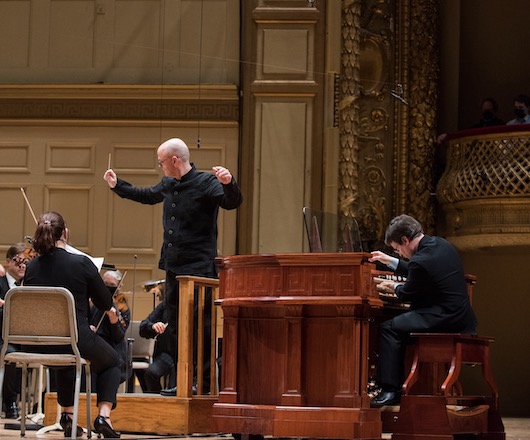Paul Jacobs’ artistry lifts BMOP’s retro program

Paul Jacobs performed music of Stephen Paulus and Joseph Jongen with Gil Rose and the Boston Modern Orchestra Project Friday night at Symphony Hall. Photo: Sam Brewer
“Pulling Out All the Stops,” Friday night’s belated Boston Modern Orchestra Project season-opener, was not your typical BMOP affair. For one, the venue was different—Symphony Hall, instead of Jordan Hall—and the audience was bigger and noisier than usual.
Then there was the evening’s program. To mark the start of the ensemble’s 25th season, BMOP and conductor Gil Rose offered a night of decidedly conservative fare: splashy, festive, organ-centric music, most of which would have been considered “modern” a century ago.
Lest one worry Rose and Company have lost a step during the pandemic, this practice is firmly in keeping with the orchestra’s mission to showcase the diversity of music written over the last hundred years. Still, it was a touch jarring to be faced with a BMOP concert—especially the group’s first in more than two years—that featured no works by living composers.
Nevertheless, the performances the ensemble and guest organist Paul Jacobs offered left little to be desired.
Jacobs is a musician of astonishing abilities. He has, of course, all his instrument’s technical demands perfectly in hand (and feet). But most striking is Jacobs’ ear for voicings and balances, as well as his intuitive grasp of the spirit of the music at hand.
This was evident in his performances of both of Friday’s nights concertos: Stephen Paulus’s Grand Concerto for Organ and Orchestra and Joseph Jongen’s Symphonie Concertante for Organ and Orchestra, respectively—as well as his captivating encore of J. S. Bach’s Fugue in A minor (BWV 543).
Premiered in 2004, the Paulus Grand Concerto is firmly rooted in the American Romantic tradition. Its three movements move between clearly delineated thematic ideas and expressive areas. Though thoroughly idiomatic in its solo writing, there’s never the sense of Paulus indulging in gestures or textures for the sake of hackneyed effect; rather, every statement in the piece—big or little—serves an overriding dramatic purpose.
Accordingly, Jacobs’ reading on Friday subtly underlined its contrasts of character, from the first movement’s genial call-and-response figures to the second’s plaintive tonal shadings and the finale’s jovial exclamations. The last came off with conspicuous brilliance, particularly the mid-movement hockets between various orchestral families and organ, and the wild pedal cadenza with percussion.
For his part, Rose drew a strongly balanced, fluent accompaniment from BMOP. The slow movement’s fervent climax—which turns, terrifyingly, on a dime—resolved with admirable consolatory conviction, and the larger piece proved a revelation: this is precisely the type of accessible, crafty contemporary music top-tier orchestras ought to be lining up to play.
That’s not quite the situation for Jongen’s Symphonie Concertante. Written in 1926, it’s a substantial work. Yet, even in Jacobs’ capable hands, the piece felt verbose.
Granted, there were striking moments. The first movement’s dreamy ending unfolded with enchanting warmth. Jacobs and Rose brought winning style to the Divertimento’s cheekily shifting moods. Woodwind solos in the third movement were articulated with breathtaking tonal unanimity. Also, the finale’s heaving, Technicolor figures culminated in a rousing final cadence.
Even so, the Symphonie Concertante didn’t add up to the sum of its parts. At about thirty-five minutes, its arguments run dry and the score simply overstays its welcome, for all its moments of brilliance and bombast.
The last wasn’t an issue, though, with either Edward Elgar’s arrangement of Bach’s Fantasia and Fugue or Olivier Messiaen’s L’ascension.
Elgar’s adaptation of Bach’s BWV 537, completed in 1922, is a saucy, kaleidoscopic effort. On Friday, its balances were all smartly controlled. Though the vigorous Fugue proved a touch unrefined, texturally, its elemental swirling figures all projected thrillingly.
Messiaen’s 1933 score exists in two versions; the one for orchestra is, in spots, considerably different from that for organ. Despite its early authorship, though, nearly all the hallmarks of the composer’s mature style—surging dissonances, asymmetric rhythms, liturgical awareness among them—are evident in its pages.
On Friday, L’ascension’s outer movements sang with lush intensity; the first’s resplendent phrases, especially, gleamed like a torch illuminating a dark passageway. Meanwhile, the second section’s blends of rhythmic, harmonic, and tonal dissonance were perfectly measured and the “Alleluia sur le trompete’s” earthy rhythms contrasted potently with its sensuous, lyrical turns.
BMOP plays music by Ellen Taaffe Zwilich at 8 p.m. April 8 at Jordan Hall. BMOP.org
Posted in Performances



